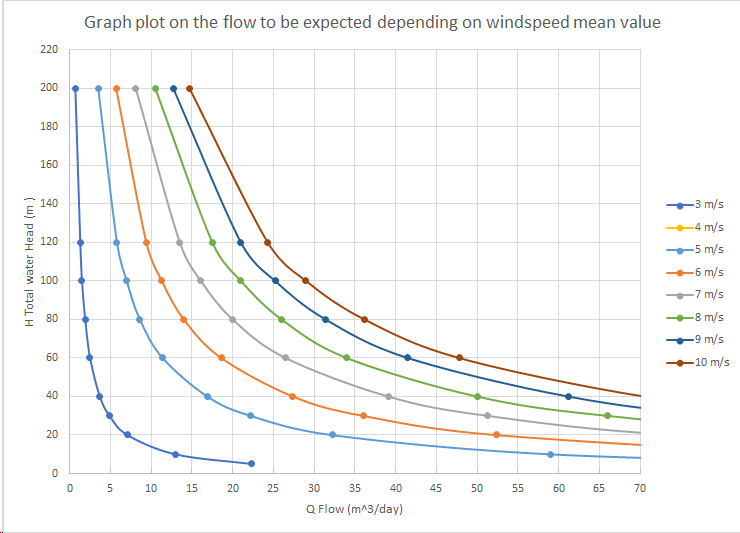A simple spreadsheet for water pumping calculations
25 views
Skip to first unread message
Jean Alinei
Feb 4, 2019, 6:26:26 PM2/4/19
to Technology WG (Wind Empowerment)
Hey all,

Together with the joint water pumping team, we have developped a spreadsheet to estimate the water pumping capabilities of a pigott turbine for a given site.
It is still an ongoing development but it would be great to collect your feedback at an early stage to be able to develop a tool usefull for everyone.
It lies on the assumptions that all the energy from the wind turbine can be used to pump water. In other term, it would correspond to a case where the capacity of the storage is large enough to accomodate the delta between instantaneous generated power and instantaneous supply for the pump.
The efficiency have been "calibrated" with a cross check with Grundfos (A pump manufacturer) online tool.
Here is a summary of our findings in one graph :
This graph represent the expected daily flow for different windspeed, with a 4.2m Pigott turbine for different depth of well.
If you find any bug, or you do not understand something, please let me know !
Cheers,
Cheers,
Jean
Noam Dotan
Feb 5, 2019, 2:27:37 AM2/5/19
to Technology WG (Wind Empowerment)
Hi. The daily flow capacity is a bit misleading. How many hours of wind a day did you assume?I suggest you plot it for LPM and indicate the turbine efficiency and the pump efficiency. also indicate the model of the pump. thanks. Noam
Jean Alinei
Feb 25, 2019, 4:27:42 PM2/25/19
to Technology WG (Wind Empowerment)
Hey Noam,
This model is calculating the flow from wind assumption using a probabilistic approach, with a Weibull distribution. So the flow is calculated assuming a wind repartition (see the excel spreadsheet attached to the first post). The daily flow is deduced from the annual flow with the hypothesis that the repartition is the same all the year long.
All the efficiencies are shown in the spreadsheet. They are parameters that you can change from the info you can get from your local pump manufacturer. The flow in LPM is also available on it.
The model of the pump used to plot the graphs are submersible pumps. The spreadsheet indend to give a rough estimate of what are the capabilities of a wind-pumping system. Is it not 100% accurate and dedicated to one precise kind of pump.
All the efficiencies are shown in the spreadsheet. They are parameters that you can change from the info you can get from your local pump manufacturer. The flow in LPM is also available on it.
The model of the pump used to plot the graphs are submersible pumps. The spreadsheet indend to give a rough estimate of what are the capabilities of a wind-pumping system. Is it not 100% accurate and dedicated to one precise kind of pump.
Best,
Jean
Noam Dotan
Feb 26, 2019, 2:33:56 AM2/26/19
to Technology WG (Wind Empowerment)
Hello Jean.
Thanks for the answer.
So if I look at the spreadsheet, I see for instance that at 10 m/s wind your turbine produces 637 Watts and 1080 L/H, calculating the overall efficiency of pumping water from 50 m pump head I find out that the efficiency is 23.5% . (LPS*head*9.8/input power) that is quite low. For instance in solar pumping one reaches 35-50% . our solar pump developed at Comet-ME reaches some 45-52%. The total efficiency number is very important both for the wind pumping and the solar pumping because it dictates the number of solar panels and the size of the turbine. both have an affect on the cost.
Also it is not clear why below 10 m/s wind speed there is no flow, while the most probable wind speed is between 3 to 6 m/s. for me it means that running a pump with a wind turbine you need to add a battery to store the energy and operate the pump in the required time. This add more to the costs.
At Comet-ME we spend about a year experimenting with direct drive wind pumps. We designed and built an efficient helical savonius and build a double action piston pump. The idea was to come up with a real low cost solution to pump water. After long research and experiment we were not convinced that this is the right direction. We have started about 5 years to design a unique solar pump that is based on a linear motor driving directly a piston that pumps water in a double action mode. Pump is designed for 15-45 m head with daily capacity of 20-30 cubic meters with 600Wp solar power. We target the pump for small landowners for irrigation. We believe this pump will be at 1/3 of existing good quality pumps and will be more reliable and much easy to service even at field level.
Best. Noam
On Tuesday, February 5, 2019 at 1:26:26 AM UTC+2, Jean Alinei wrote:
Reply all
Reply to author
Forward
0 new messages
